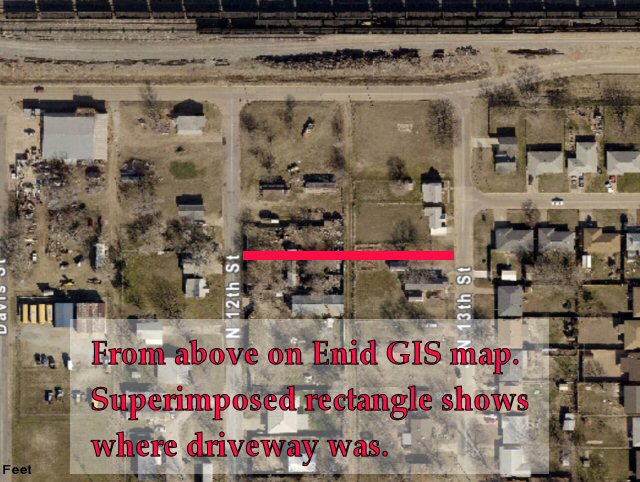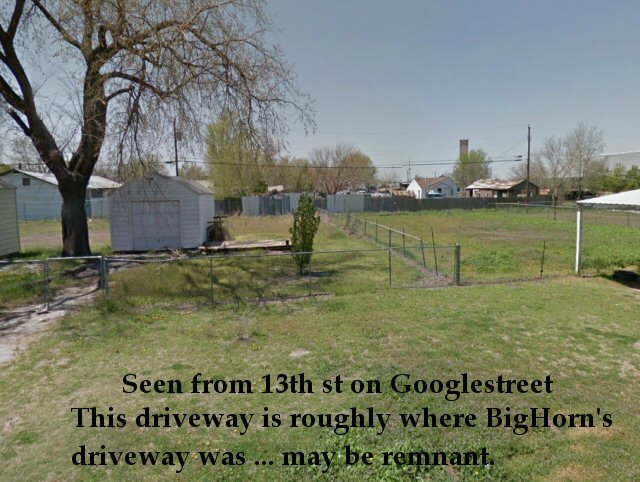Sunday, January 05, 2014
The mysterious Big Horn
In the era of satellite pix and Flickr and Instagram, odd places are thoroughly documented online in precision digital form.
Mysterious places that disappeared before the current era have to be pulled back to life by sloppier analog methods. I've pulled back several such places in my graphics freestuff.
One mysterious place in Enid sent me an ethereal ping tonight, asking to be pulled back. I don't have enough time this month to make a proper model, and I don't have a clear enough memory of the place anyway. I'll try to cobble together a picture from pieces of my other models and pieces of my cloudy memory.
 This is a vague impression of a building called THE BIG HORN. Its address would have been about 1340 N. 13th St in Enid. When I lived near it in 1972 it was abandoned, nearly hidden behind trees and fences in the middle of a residential block. It appeared to be fairly well-maintained and intact with restaurant fixtures inside. I've "drawn" it here as a drive-in, but I suspect it was intended as a walk-up, with the arches covering an outside picnic-style eating area. The location, just south of a major railroad yard and grain elevator, would have made sense as a walk-up lunch counter for working men.
I guessed from the intact condition that the building had been fully abandoned for only 10 years, but it couldn't have been an active business through the '50s and '60s. Trees and fences were much older. City directories listed The Big Horn exactly once, as a "club" in 1938. In Oklahoma, where nominal Prohibition lasted until 1959, a "club" was a speakeasy.
This is a vague impression of a building called THE BIG HORN. Its address would have been about 1340 N. 13th St in Enid. When I lived near it in 1972 it was abandoned, nearly hidden behind trees and fences in the middle of a residential block. It appeared to be fairly well-maintained and intact with restaurant fixtures inside. I've "drawn" it here as a drive-in, but I suspect it was intended as a walk-up, with the arches covering an outside picnic-style eating area. The location, just south of a major railroad yard and grain elevator, would have made sense as a walk-up lunch counter for working men.
I guessed from the intact condition that the building had been fully abandoned for only 10 years, but it couldn't have been an active business through the '50s and '60s. Trees and fences were much older. City directories listed The Big Horn exactly once, as a "club" in 1938. In Oklahoma, where nominal Prohibition lasted until 1959, a "club" was a speakeasy.

 A modern aerial view and Googlestreet indicate the former location. I've sort of superimposed the driveway on the aerial. This part of 13th hasn't changed much since 1972. Davis and 12th have been largely stripped of houses and turned into industrial areas. Probably a good thing in terms of employment.
Much of the east side of Enid has been de-housed in the last 10 years. Not quite Detroit, but getting there. Perhaps wisely, the area that suffered the worst flooding in 1973 has been returned to prairie, though it was fully rebuilt after the flood and occupied for 30 years.
By the numbers, it looks like Enid is back in a boom phase. After dramatic drops in income and population during the '90s, its current pop and income levels are back to normal and growing fast... but abandoning the East side. This is just the latest repetition of the boom-bust ratchet that keeps Okla towns fresh. Booms bring in new workers who can afford new houses. New subdivisions sprawl. When the boom breaks the temporary workers leave, and the remaining locals bubble upward, level by level, into better houses which are now more affordable. The bottom level, the worst houses, are abandoned and eventually torn down.
Continued the topic here.
= = = = =
Footnote for clarity: The Big Horn, an attempted restaurant that probably never opened for business, is NOT to be confused with the Longhorn at 4th and Willow, a highly popular and successful restaurant that served big steaks and yummy Mexican food.
A modern aerial view and Googlestreet indicate the former location. I've sort of superimposed the driveway on the aerial. This part of 13th hasn't changed much since 1972. Davis and 12th have been largely stripped of houses and turned into industrial areas. Probably a good thing in terms of employment.
Much of the east side of Enid has been de-housed in the last 10 years. Not quite Detroit, but getting there. Perhaps wisely, the area that suffered the worst flooding in 1973 has been returned to prairie, though it was fully rebuilt after the flood and occupied for 30 years.
By the numbers, it looks like Enid is back in a boom phase. After dramatic drops in income and population during the '90s, its current pop and income levels are back to normal and growing fast... but abandoning the East side. This is just the latest repetition of the boom-bust ratchet that keeps Okla towns fresh. Booms bring in new workers who can afford new houses. New subdivisions sprawl. When the boom breaks the temporary workers leave, and the remaining locals bubble upward, level by level, into better houses which are now more affordable. The bottom level, the worst houses, are abandoned and eventually torn down.
Continued the topic here.
= = = = =
Footnote for clarity: The Big Horn, an attempted restaurant that probably never opened for business, is NOT to be confused with the Longhorn at 4th and Willow, a highly popular and successful restaurant that served big steaks and yummy Mexican food.
 This is a vague impression of a building called THE BIG HORN. Its address would have been about 1340 N. 13th St in Enid. When I lived near it in 1972 it was abandoned, nearly hidden behind trees and fences in the middle of a residential block. It appeared to be fairly well-maintained and intact with restaurant fixtures inside. I've "drawn" it here as a drive-in, but I suspect it was intended as a walk-up, with the arches covering an outside picnic-style eating area. The location, just south of a major railroad yard and grain elevator, would have made sense as a walk-up lunch counter for working men.
I guessed from the intact condition that the building had been fully abandoned for only 10 years, but it couldn't have been an active business through the '50s and '60s. Trees and fences were much older. City directories listed The Big Horn exactly once, as a "club" in 1938. In Oklahoma, where nominal Prohibition lasted until 1959, a "club" was a speakeasy.
This is a vague impression of a building called THE BIG HORN. Its address would have been about 1340 N. 13th St in Enid. When I lived near it in 1972 it was abandoned, nearly hidden behind trees and fences in the middle of a residential block. It appeared to be fairly well-maintained and intact with restaurant fixtures inside. I've "drawn" it here as a drive-in, but I suspect it was intended as a walk-up, with the arches covering an outside picnic-style eating area. The location, just south of a major railroad yard and grain elevator, would have made sense as a walk-up lunch counter for working men.
I guessed from the intact condition that the building had been fully abandoned for only 10 years, but it couldn't have been an active business through the '50s and '60s. Trees and fences were much older. City directories listed The Big Horn exactly once, as a "club" in 1938. In Oklahoma, where nominal Prohibition lasted until 1959, a "club" was a speakeasy.

 A modern aerial view and Googlestreet indicate the former location. I've sort of superimposed the driveway on the aerial. This part of 13th hasn't changed much since 1972. Davis and 12th have been largely stripped of houses and turned into industrial areas. Probably a good thing in terms of employment.
Much of the east side of Enid has been de-housed in the last 10 years. Not quite Detroit, but getting there. Perhaps wisely, the area that suffered the worst flooding in 1973 has been returned to prairie, though it was fully rebuilt after the flood and occupied for 30 years.
By the numbers, it looks like Enid is back in a boom phase. After dramatic drops in income and population during the '90s, its current pop and income levels are back to normal and growing fast... but abandoning the East side. This is just the latest repetition of the boom-bust ratchet that keeps Okla towns fresh. Booms bring in new workers who can afford new houses. New subdivisions sprawl. When the boom breaks the temporary workers leave, and the remaining locals bubble upward, level by level, into better houses which are now more affordable. The bottom level, the worst houses, are abandoned and eventually torn down.
Continued the topic here.
= = = = =
Footnote for clarity: The Big Horn, an attempted restaurant that probably never opened for business, is NOT to be confused with the Longhorn at 4th and Willow, a highly popular and successful restaurant that served big steaks and yummy Mexican food.
A modern aerial view and Googlestreet indicate the former location. I've sort of superimposed the driveway on the aerial. This part of 13th hasn't changed much since 1972. Davis and 12th have been largely stripped of houses and turned into industrial areas. Probably a good thing in terms of employment.
Much of the east side of Enid has been de-housed in the last 10 years. Not quite Detroit, but getting there. Perhaps wisely, the area that suffered the worst flooding in 1973 has been returned to prairie, though it was fully rebuilt after the flood and occupied for 30 years.
By the numbers, it looks like Enid is back in a boom phase. After dramatic drops in income and population during the '90s, its current pop and income levels are back to normal and growing fast... but abandoning the East side. This is just the latest repetition of the boom-bust ratchet that keeps Okla towns fresh. Booms bring in new workers who can afford new houses. New subdivisions sprawl. When the boom breaks the temporary workers leave, and the remaining locals bubble upward, level by level, into better houses which are now more affordable. The bottom level, the worst houses, are abandoned and eventually torn down.
Continued the topic here.
= = = = =
Footnote for clarity: The Big Horn, an attempted restaurant that probably never opened for business, is NOT to be confused with the Longhorn at 4th and Willow, a highly popular and successful restaurant that served big steaks and yummy Mexican food.Labels: Danbo, Heimatkunde
